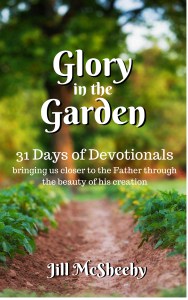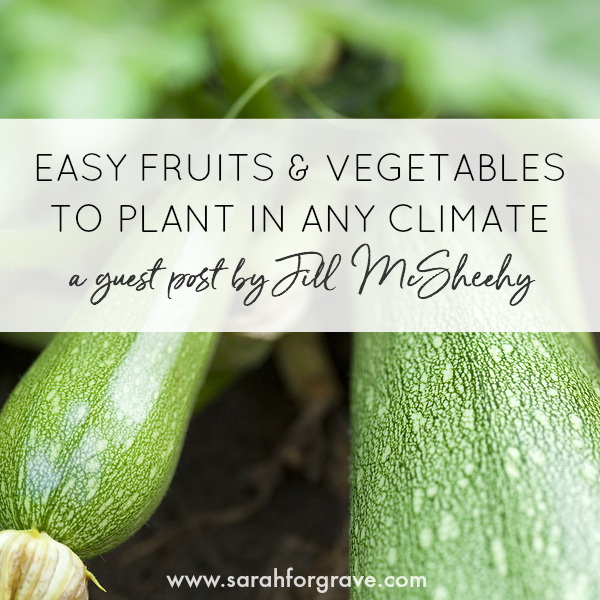If there’s one thing I’ve always dreamed of, it’s having a huge organic garden in my backyard. In my dream, I step outside, pick from dozens of fresh fruits and vegetables, and place them on the dinner table in a Pinterest-worthy spread. Sad thing is, while I love eating healthy foods, I wasn’t gifted with a green thumb to GROW said foods.
That’s where today’s guest author comes in. Jill McSheehy has a huge passion and talent for gardening. (You can read more about her blog, Journey with Jill, and her books about gardening and faith in her bio below.) Today she’s here to share 5 fruits and vegetables that are easy to plant and that grow well in any climate. In fact, I’m so inspired, I might just give one of these a try!
Without further ado, here’s Jill…
When I first started gardening four years ago, I didn’t have a clue what I was doing. But I had a goal to cut down on our grocery bill and eat healthier so I was determined to become a gardener.
After much trial and error, I learned some plants were simply easier to plant and grow than others. If you’re beginning a gardening endeavor, whether large or small, these 5 fruits and vegetables promise to be both fairly simple to grow and boast numerous health benefits as well.
1. Blueberries
Blueberries are heralded as one of the most nutritious fruits available, loaded with antioxidants and bursting with flavor. Store-bought blueberries are not only expensive, but their taste doesn’t compare to the warm, sweet juice of a berry picked from your own back yard.
Surprisingly, if you just follow a few steps when you first plant your blueberry bushes (and you need more than one for cross-pollination), you’ll find yourself picking berries for years, even decades, with very little effort each year. Now that my bushes are established, I only have to add some compost or organic fertilizer once in the spring and keep them watered and mulched.
To get started, I recommend you visit your local nursery. Blueberry varieties differ depending on your climate, and by purchasing locally, you can ensure you’re choosing the best bush for your area. The people working at your nursery will give you tips on planting if you’ll just ask. I also compiled 4 beginner mistakes you can avoid to easily get started HERE.
2. Green Beans
 One of the most popular garden crops in all areas of the country, green beans are a cinch to grow. They aren’t picky with their soil and only require you to wait until the soil warms to at least 65 degrees (usually a couple of weeks after your last frost) for proper germination. Beans do best when you plant them as seeds, not as transplants, which also saves you money.
One of the most popular garden crops in all areas of the country, green beans are a cinch to grow. They aren’t picky with their soil and only require you to wait until the soil warms to at least 65 degrees (usually a couple of weeks after your last frost) for proper germination. Beans do best when you plant them as seeds, not as transplants, which also saves you money.
You will have to choose whether to grow pole beans or bush beans, which I explain further HERE. Again, I recommend purchasing seeds from your local nursery or farmer’s co-op, though bean varieties aren’t as particular about climate.
Just a little bit of effort and garden space can yield you enough home-grown green beans for the entire year if you want, and you can either can preserve them through canning or freezing. (Canning green beans requires a pressure canner but is very easy.)
3. Zucchini or Squash
You’ve probably heard tales of gardeners sneaking onto their neighbors’ porches, dropping off bags full of zucchini. Taking up very little garden space and requiring only a couple plants to feed your family and more, zucchini and yellow squash are great beginner vegetables.
This is another plant that doesn’t do well transplanted, but it’s easily started by plopping a seed in the ground when the soil warms. Most experts recommend building a mound about 6″ high and 3′ in diameter and planting several seeds in a circle at the top of the mound. (When they begin growing, remove all but the three best plants.) Because zucchini is a heavy feeder, incorporating compost will stimulate abundant growth.
Young zucchini and squash are delicious sautéed with onions, olive oil, a pinch of garlic, salt, and pepper. Larger zucchini can be shredded for delicious zucchini bread.
4. Potatoes
 This may surprise you, but if you have a little bit of garden space, I’ve found potatoes extremely easy to grow and especially fun to harvest. A typical cool-weather crop, I’ve had success in my southern garden by planting them in late February or early March and they’re ready to harvest before the extreme heat arrives.
This may surprise you, but if you have a little bit of garden space, I’ve found potatoes extremely easy to grow and especially fun to harvest. A typical cool-weather crop, I’ve had success in my southern garden by planting them in late February or early March and they’re ready to harvest before the extreme heat arrives.
All that’s required is buying “seed” potatoes from your local nursery or Farmer’s Co-op. Seed potatoes look like what you buy at the grocery store (but don’t use store potatoes — they’re sprayed to prohibit growth), and you simply drop them in a 4″ x 4″ trench (easily dug with a garden hoe) with the “eyes” facing up and cover them up. After the vines, which take several weeks to poke through, get up to 12″ tall, take the hoe and “hill” up dirt around the vines. This hill is where the potatoes will grow. When the vines begin to die in 2-3 months, they’re ready to dig up.
Home-grown potatoes offer notable health benefits besides their rich supply of fiber, Vitamin C, potassium, and a host of other nutrients. Store-bought non-organic potatoes were found by the Environmental Working Group to have more pesticides by weight than any other produce. That’s one big reason for our garden to have ample room dedicated to homegrown spuds.
5. Cucumbers
Cucumbers are such a versatile plant, and they take very little effort to grow. Their growth habit is similar to zucchini, though they can benefit from a trellis to climb. Plant them at the same time as zucchini, and plant them with seed (they do not transplant well). Mix some compost into the planting area and watch them grow.
If you want cucumbers for only fresh eating, choose a slicing variety. If you’d like the additional benefit of making pickles, whether by canning them or freezing them, a pickling variety is best. My favorite use of cucumbers is making homemade sweet pickle relish from the Ball Blue Book of canning. My relatives ask for jars of it every Christmas.
Like zucchini, be prepared. Cucumbers produce so heavily with just a few plants, you may end up begging your neighbors to take them off your hands.
Starting a garden is actually easier than you think, and even if you plant just one crop, you’re not only taking one more step to healthier eating, you’ll reap the numerous physical and mental rewards of gardening.
 Jill McSheehy is the author of Flourish — a book about composting and faith. Her first book, Glory in the Garden: 31 Days of Devotionals, was birthed from her early gardening experiences. A Bible teacher at heart, Jill blogs at www.journeywithjill.net, where she writes about her faith, family, and garden. She, her husband Matt of nearly 15 years, and their children, Drew and Alyssa, make their home in Arkansas, where they enjoy tending to a large garden, six chickens (and counting), and three compost piles.
Jill McSheehy is the author of Flourish — a book about composting and faith. Her first book, Glory in the Garden: 31 Days of Devotionals, was birthed from her early gardening experiences. A Bible teacher at heart, Jill blogs at www.journeywithjill.net, where she writes about her faith, family, and garden. She, her husband Matt of nearly 15 years, and their children, Drew and Alyssa, make their home in Arkansas, where they enjoy tending to a large garden, six chickens (and counting), and three compost piles.
Zucchini photo by Jacques Palut/BigStock.com
